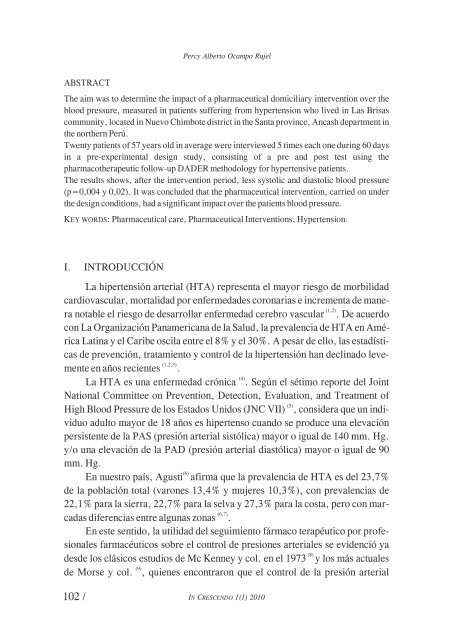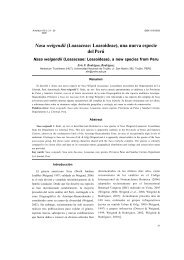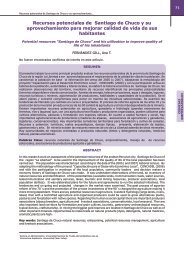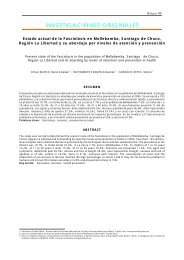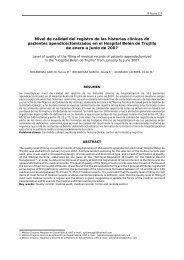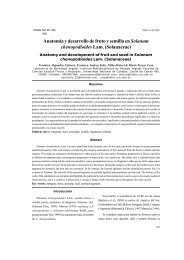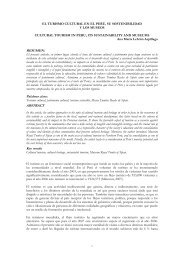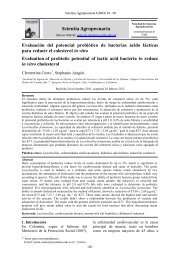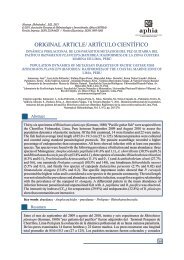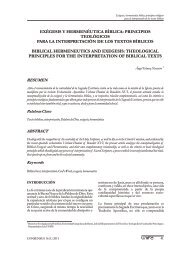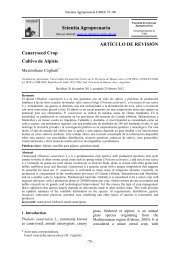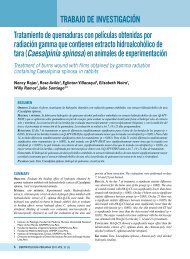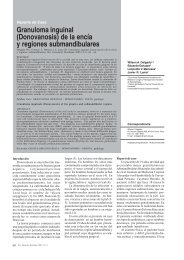INCRESCENDO 1(1) 2010 - Revista Peruana
INCRESCENDO 1(1) 2010 - Revista Peruana
INCRESCENDO 1(1) 2010 - Revista Peruana
Create successful ePaper yourself
Turn your PDF publications into a flip-book with our unique Google optimized e-Paper software.
ABSTRACT<br />
The aim was to determine the impact of a pharmaceutical domiciliary intervention over the<br />
blood pressure, measured in patients suffering from hypertension who lived in Las Brisas<br />
community, located in Nuevo Chimbote district in the Santa province, Ancash department in<br />
the northern Perú.<br />
Twenty patients of 57 years old in average were interviewed 5 times each one during 60 days<br />
in a pre-experimental design study, consisting of a pre and post test using the<br />
pharmacotherapeutic follow-up DADER methodology for hypertensive patients.<br />
The results shows, after the intervention period, less systolic and diastolic blood pressure<br />
(p=0,004 y 0,02). It was concluded that the pharmaceutical intervention, carried on under<br />
the design conditions, had a significant impact over the patients blood pressure.<br />
KEY WORDS: Pharmaceutical care, Pharmaceutical Interventions, Hypertension.<br />
I. INTRODUCCIÓN<br />
102 /<br />
Percy Alberto Ocampo Rujel<br />
La hipertensión arterial (HTA) representa el mayor riesgo de morbilidad<br />
cardiovascular, mortalidad por enfermedades coronarias e incrementa de mane-<br />
(1,2)<br />
ra notable el riesgo de desarrollar enfermedad cerebro vascular . De acuerdo<br />
con La Organización Panamericana de la Salud, la prevalencia de HTA en América<br />
Latina y el Caribe oscila entre el 8% y el 30%. A pesar de ello, las estadísticas<br />
de prevención, tratamiento y control de la hipertensión han declinado leve-<br />
(1,2,3)<br />
mente en años recientes .<br />
(4)<br />
La HTA es una enfermedad crónica . Según el sétimo reporte del Joint<br />
National Committee on Prevention, Detection, Evaluation, and Treatment of<br />
(5)<br />
High Blood Pressure de los Estados Unidos (JNC VII) , considera que un individuo<br />
adulto mayor de 18 años es hipertenso cuando se produce una elevación<br />
persistente de la PAS (presión arterial sistólica) mayor o igual de 140 mm. Hg.<br />
y/o una elevación de la PAD (presión arterial diastólica) mayor o igual de 90<br />
mm. Hg.<br />
(6)<br />
En nuestro país, Agusti afirma que la prevalencia de HTA es del 23,7%<br />
de la población total (varones 13,4% y mujeres 10,3%), con prevalencias de<br />
22,1% para la sierra, 22,7% para la selva y 27,3% para la costa, pero con mar-<br />
(6,7)<br />
cadas diferencias entre algunas zonas .<br />
En este sentido, la utilidad del seguimiento fármaco terapéutico por profesionales<br />
farmacéuticos sobre el control de presiones arteriales se evidenció ya<br />
(8)<br />
desde los clásicos estudios de Mc Kenney y col. en el 1973 y los más actuales<br />
(9)<br />
de Morse y col. , quienes encontraron que el control de la presión arterial<br />
IN CRESCENDO 1(1) <strong>2010</strong>


